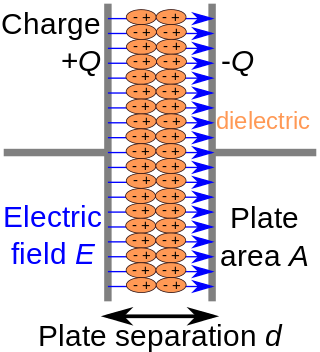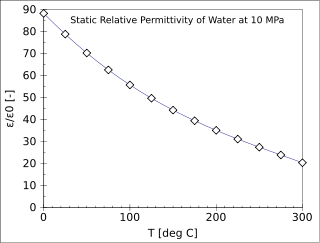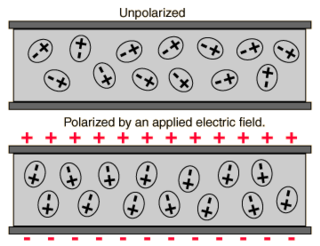
In electromagnetism, a dielectric is an electrical insulator that can be polarised by an applied electric field. When a dielectric material is placed in an electric field, electric charges do not flow through the material as they do in an electrical conductor, because they have no loosely bound, or free, electrons that may drift through the material, but instead they shift, only slightly, from their average equilibrium positions, causing dielectric polarisation. Because of dielectric polarisation, positive charges are displaced in the direction of the field and negative charges shift in the direction opposite to the field. This creates an internal electric field that reduces the overall field within the dielectric itself. If a dielectric is composed of weakly bonded molecules, those molecules not only become polarised, but also reorient so that their symmetry axes align to the field.
The wave impedance of an electromagnetic wave is the ratio of the transverse components of the electric and magnetic fields. For a transverse-electric-magnetic (TEM) plane wave traveling through a homogeneous medium, the wave impedance is everywhere equal to the intrinsic impedance of the medium. In particular, for a plane wave travelling through empty space, the wave impedance is equal to the impedance of free space. The symbol Z is used to represent it and it is expressed in units of ohms. The symbol η (eta) may be used instead of Z for wave impedance to avoid confusion with electrical impedance.

The relative permittivity is the permittivity of a material expressed as a ratio with the electric permittivity of a vacuum. A dielectric is an insulating material, and the dielectric constant of an insulator measures the ability of the insulator to store electric energy in an electrical field.

In electromagnetism, the absolute permittivity, often simply called permittivity and denoted by the Greek letter ε (epsilon), is a measure of the electric polarizability of a dielectric. A material with high permittivity polarizes more in response to an applied electric field than a material with low permittivity, thereby storing more energy in the material. In electrostatics, the permittivity plays an important role in determining the capacitance of a capacitor.

The Drude model of electrical conduction was proposed in 1900 by Paul Drude to explain the transport properties of electrons in materials. Basically, Ohm's law was well established and stated that the current J and voltage V driving the current are related to the resistance R of the material. The inverse of the resistance is known as the conductance. When we consider a metal of unit length and unit cross sectional area, the conductance is known as the conductivity, which is the inverse of resistivity. The Drude model attempts to explain the resistivity of a conductor in terms of the scattering of electrons by the relatively immobile ions in the metal that act like obstructions to the flow of electrons.
In physics, the dissipation factor (DF) is a measure of loss-rate of energy of a mode of oscillation in a dissipative system. It is the reciprocal of quality factor, which represents the "quality" or durability of oscillation.
Plasma oscillations, also known as Langmuir waves, are rapid oscillations of the electron density in conducting media such as plasmas or metals in the ultraviolet region. The oscillations can be described as an instability in the dielectric function of a free electron gas. The frequency depends only weakly on the wavelength of the oscillation. The quasiparticle resulting from the quantization of these oscillations is the plasmon.
In physics and engineering, a constitutive equation or constitutive relation is a relation between two physical quantities that is specific to a material or substance, and approximates the response of that material to external stimuli, usually as applied fields or forces. They are combined with other equations governing physical laws to solve physical problems; for example in fluid mechanics the flow of a fluid in a pipe, in solid state physics the response of a crystal to an electric field, or in structural analysis, the connection between applied stresses or loads to strains or deformations.

In physics, the electric displacement field or electric induction is a vector field that appears in Maxwell's equations. It accounts for the electromagnetic effects of polarization and that of an electric field, combining the two in an auxiliary field. It plays a major role in topics such as the capacitance of a material, as well the response of dielectrics to electric field, and how shapes can change due to electric fields in piezoelectricity or flexoelectricity as well as the creation of voltages and charge transfer due to elastic strains.
In classical electromagnetism, reciprocity refers to a variety of related theorems involving the interchange of time-harmonic electric current densities (sources) and the resulting electromagnetic fields in Maxwell's equations for time-invariant linear media under certain constraints. Reciprocity is closely related to the concept of symmetric operators from linear algebra, applied to electromagnetism.
In electrical engineering, dielectric loss quantifies a dielectric material's inherent dissipation of electromagnetic energy. It can be parameterized in terms of either the loss angleδ or the corresponding loss tangenttan(δ). Both refer to the phasor in the complex plane whose real and imaginary parts are the resistive (lossy) component of an electromagnetic field and its reactive (lossless) counterpart.
The word electricity refers generally to the movement of electrons through a conductor in the presence of a potential difference or an electric field. The speed of this flow has multiple meanings. In everyday electrical and electronic devices, the signals travel as electromagnetic waves typically at 50%–99% of the speed of light in vacuum, while the electrons themselves move much more slowly; see drift velocity and electron mobility.
In materials science, effective medium approximations (EMA) or effective medium theory (EMT) pertain to analytical or theoretical modeling that describes the macroscopic properties of composite materials. EMAs or EMTs are developed from averaging the multiple values of the constituents that directly make up the composite material. At the constituent level, the values of the materials vary and are inhomogeneous. Precise calculation of the many constituent values is nearly impossible. However, theories have been developed that can produce acceptable approximations which in turn describe useful parameters including the effective permittivity and permeability of the materials as a whole. In this sense, effective medium approximations are descriptions of a medium based on the properties and the relative fractions of its components and are derived from calculations, and effective medium theory. There are two widely used formulae.
When an electromagnetic wave travels through a medium in which it gets attenuated, it undergoes exponential decay as described by the Beer–Lambert law. However, there are many possible ways to characterize the wave and how quickly it is attenuated. This article describes the mathematical relationships among:

Surface plasmon polaritons (SPPs) are electromagnetic waves that travel along a metal–dielectric or metal–air interface, practically in the infrared or visible-frequency. The term "surface plasmon polariton" explains that the wave involves both charge motion in the metal and electromagnetic waves in the air or dielectric ("polariton").

In condensed matter physics, the Lyddane–Sachs–Teller relation determines the ratio of the natural frequency of longitudinal optic lattice vibrations (phonons) of an ionic crystal to the natural frequency of the transverse optical lattice vibration for long wavelengths. The ratio is that of the static permittivity to the permittivity for frequencies in the visible range .
In the physics of continuous media, spatial dispersion is usually described as a phenomenon where material parameters such as permittivity or conductivity have dependence on wavevector. Normally, such a dependence is assumed to be absent for simplicity, however spatial dispersion exists to varying degrees in all materials.
Spoof surface plasmons, also known as spoof surface plasmon polaritons and designer surface plasmons, are surface electromagnetic waves in microwave and terahertz regimes that propagate along planar interfaces with sign-changing permittivities. Spoof surface plasmons are a type of surface plasmon polariton, which ordinarily propagate along metal and dielectric interfaces in infrared and visible frequencies. Since surface plasmon polaritons cannot exist naturally in microwave and terahertz frequencies due to dispersion properties of metals, spoof surface plasmons necessitate the use of artificially-engineered metamaterials.

The Brendel–Bormann oscillator model is a mathematical formula for the frequency dependence of the complex-valued relative permittivity, sometimes referred to as the dielectric function. The model has been used to fit to the complex refractive index of materials with absorption lineshapes exhibiting non-Lorentzian broadening, such as metals and amorphous insulators, across broad spectral ranges, typically near-ultraviolet, visible, and infrared frequencies. The dispersion relation bears the names of R. Brendel and D. Bormann, who derived the model in 1992, despite first being applied to optical constants in the literature by Andrei M. Efimov and E. G. Makarova in 1983. Around that time, several other researchers also independently discovered the model. The Brendel-Bormann oscillator model is aphysical because it does not satisfy the Kramers–Kronig relations. The model is non-causal, due to a singularity at zero frequency, and non-Hermitian. These drawbacks inspired J. Orosco and C. F. M. Coimbra to develop a similar, causal oscillator model.

The Lorentz oscillator model describes the optical response of bound charges. The model is named after the Dutch physicist Hendrik Antoon Lorentz. It is a classical, phenomenological model for materials with characteristic resonance frequencies for optical absorption, e.g. ionic and molecular vibrations, interband transitions (semiconductors), phonons, and collective excitations.

















